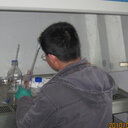A putative new domain target for anti-hepatitis B virus: residues flanking hepatitis B virus reverse transcriptase residue 306 (rtP306).
Palavras-chave
Resumo
Previous work showed that conservation of proline at residue 306 (rtP306) of hepatitis B virus (HBV) reverse transcriptase (RT) is crucial for virus replication and encapsidation of pregenomic RNA (pgRNA). In this study, the functions of residues flanking rtP306 in HBV RT (rtG304, rtY305, rtA307, rtL308 and rtL311) are presented. Alanine or phenylalanine was used to substitute these residues by constructing site-directed mutants which were used to transfect Huh-7 cells. Replication competencies and encapsidation efficiencies were compared between the mutants and the parental viral strain. Substitutions at these residues resulted in marked decrease of replication competency, which was confirmed by Southern blot hybridization of HBV DNA isolated from intracytoplasmic core particles, and trans-complementation between a non-replicative defective mutant and corresponding RT mutants. Impaired pgRNA encapsidation efficiency of these mutants was shown as the major mechanism for decreased replication efficiency. Since residues from rt304 to rt311 are highly conserved among genotypes A-H HBV strains, results suggest that rt304 to rt311 in HBV RT may serve as a putative anti-HBV new target domain.



